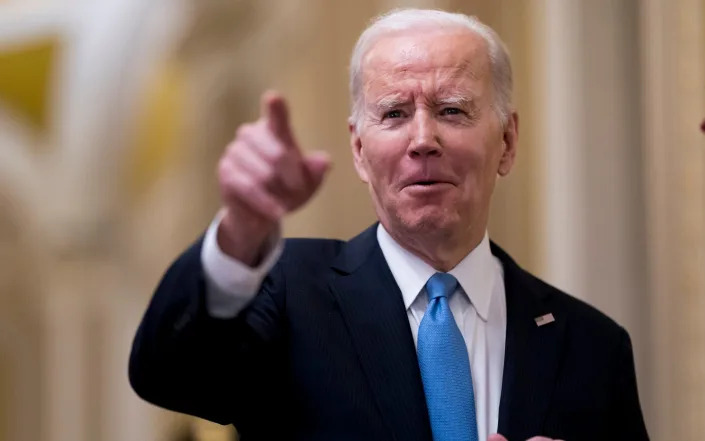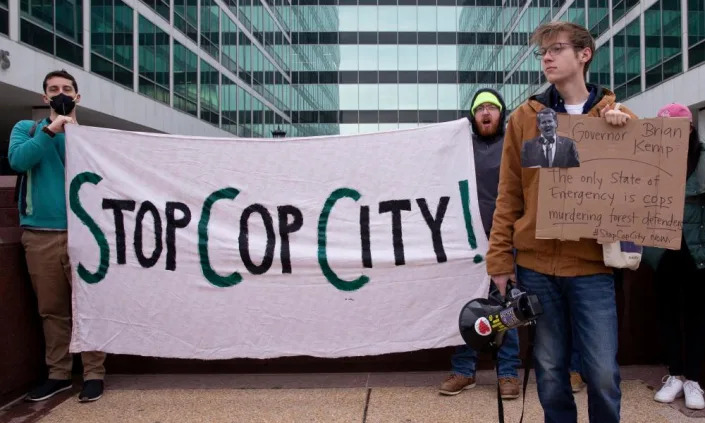Liberal “anti-populists” often portray grassroots democracy as more a threat than an asset. But as reactionaries turn to judges to win their political battles for them, it’s time the Left got serious about putting power in the hands of the majority.

People wait in line outside the US Supreme Court in Washington, DC, on February 21, 2023. (Jim Watson / AFP via Getty Images)
BYMICHAEL WILKINSON
03.05.2023
Jacobin
Interviewed in 1991, after more than a decade of Republican rule, liberal legal scholar Ronald Dworkin was asked whether he feared that, if the political tide changed, his model of an activist supreme court might be wielded by conservatives to strike down progressive legislation. Dworkin’s answer was revealing: yes, he had “nightmares” that it could happen; that placing his faith in the judiciary could be “betting on the wrong horse.”
He conceded that if this were to happen, it would weaken his faith in the principle of a powerful court overseeing a liberal interpretation of the constitution. But, he added, he wouldn’t be around to see that. And, he concluded, it was a gamble he was willing to take, because it was a structure worth preserving. He had elaborated this structure in his work in painstaking detail, advocating a principle of integrity centered on a “moral reading” of the constitution, which would be developed through the rulings of Herculean (liberal) judges.
Dworkin’s interviewer, human rights lawyer and academic Conor Gearty, then a strong opponent of judicial review, highlighted the precariousness of Dworkin’s apparently principled position in a system where political and judicial power were intertwined. He joked that perhaps Dworkin was willing to take the gamble in the hope he would be appointed to the Supreme Court by a future Democrat, President Mario Cuomo (father of the recent governor of New York). Gearty noted how grim prospects were from a progressive perspective: the celebrated constitutional right to abortion, protected since 1973 in Roe v. Wade, was in danger of being abolished over the next twelve months, the US Supreme Court having moved a long way from the liberal Warren Court of the 1950s and 1960s, and by the early 1990s having the numbers to overrule Roe.
Gearty was ahead of himself. In the ruling in Planned Parenthood v. Casey, a year after his interview with Dworkin, the Supreme Court upheld the essentials of Roe and established that the due process clause of the Fourteenth Amendment protected a woman’s right to an abortion prior to fetal viability. But fast forward thirty years, and in Dobbs v. Jackson Women’s Health Organisation, decided in June last year after a controversial leak of the draft opinion, the court finally overturned Roe (as well as Planned Parenthood v. Casey).
With the appointment of Justice Amy Coney Barrett, controversially nominated by Donald Trump just before the 2020 presidential election, the ideological shift of the court had been cemented. But no legislation needed to be struck down for this conservative coup to take effect. Social conservatives had already passed legislation against abortion in several states, in anticipation of the ruling by a newly configured court. A challenge to one of these trigger laws, in Mississippi, had led to the ruling in Dobbs. With a majority of justices holding that there is no constitutional right to abortion, the green light was given to state legislation banning it. Doubts were also cast over the status of other rulings protecting constitutional rights, such as the right to same-sex marriage.
Had Dworkin’s worst nightmare come to pass? Not exactly, or, at least, not yet. The fear expressed in his 1991 interview was about progressive majorities being thwarted by conservative justices; Dobbs merely returned the issue to the states via a new, but in other ways traditional, interpretation of the Constitution. Some states have since adopted or begun to enforce laws banning abortion; but others have expanded abortion rights and amended state constitutions to include them, including California and Michigan. In Vermont, voters overwhelmingly chose to approve, by referendum, an amendment to guarantee sexual and reproductive freedoms, including the right to abortion. The backlash against Dobbs may well have politically benefitted the Democratic Party, boosting support for Biden and the Democrats in recent midterms.
Will of the Majority?
But the current situation is even more unsettling than the nightmares envisaged by Dworkin in 1991. Back then, the mainstream debate in Anglo-American constitutional theory took place on the terrain of the justification of constitutional review of legislation and over the so-called counter-majoritarian dilemma: Why should the judicial branch be entitled to overrule the will of the majority? It pitted scholars such as Dworkin against those keen to defend majoritarian democracy as represented by Westminster-style parliamentary regimes.
As a matter of US constitutional law, however, Dworkin’s antagonists were elsewhere. The justices spearheading the conservative turn of the Supreme Court, such as Antonin Scalia, Clarence Thomas, Samuel Alito, and now Barrett, are associated with “originalism,” the belief that the constitution should be interpreted as originally intended. In the interview with Gearty (as well as in his broader body of writing), Dworkin explicitly dismissed that theory, by arguing that it doesn’t answer, but merely defers, the key question: What is the best way of interpreting that intention given all the possible ways it could be understood?
That ambiguity, and the flexibility of meaning of the original text, allowed originalism to be taken up by an array of constitutional scholars, including progressives who argued that the meaning evolves to adapt to new circumstances. Some even proposed hybrids of originalism and living constitutionalism under the rubric of “living originalism.” While diverse in detail, a feature of these debates over constitutional interpretation was that the political radicalism of originalists, as well as of their adversaries, was limited by the authority vested in the constitution itself. To the counter-majoritarian problem, these scholars had an answer unavailable to Dworkin: the founding constitutional text is underscored by the authority of “the people,” whether dead or living.
The terms of the debate began to change after September 11, 2001, when it transpired that executive power posed the real threat to civil and political liberties, as waves of emergency measures were enacted, ostensibly in response to terrorist threats concurrent with the spread of the global “war on terror.” Measures would be pushed through with little or no oversight or parliamentary scrutiny, and often by liberal governments: from torture and drone attacks, to surveillance and detention without trial, liberties were traded off for security. The massive “infrastructure of fear” created in the wake of 9/11 survived, even as the threat dissipated. This was no tyranny of a legislative majority; it was a power grab by the executive.
New Right Project
During the most recent decade, liberals (in Europe as well as the United States) have been tormented by a more troubling prospect than a piece of rogue legislation or a discrete legal transgression: the fear that conservative populists will rip up the basic rules of the game in alliance with judicial elites, and with the vast administrative state built up over the previous decades at their disposal. It is against this background that a new brand of conservatism is emerging, which rejects fidelity to the constitution and, ironically, appropriates Dworkin’s work to circumvent it.
This New Right project speaks the language of judicial deference while embracing the tremendous power and governing apparatus of the administrative state. Unfettered by any allegiance to the constitutional text, or to the principle of popular sovereignty underwriting constitutional authority, it argues for a much more aggressive and unapologetic conservative agenda. It is based, like Dworkin’s project, on political morality, but it is directed in polar opposition to his liberal worldview and without any constraints of integrity.
This new constitutional theory is based not on a reading of the constitutional text at all, but on the principles of natural law as declared by medieval theologians such as Thomas Aquinas. It abandons the liberal emphasis on the equal protection of rights in favor of government directed toward the “common good.” But it doesn’t go far in saying what that means — beyond stipulating the rejection of progressive rights such as same-sex marriage and freedom of speech and dismissing libertarian rights to unfettered use of individual property. And it doesn’t advocate any project of explicit constitutional change to get there.
While confused as constitutional theory, politically, the idea of the New Right appears to be to unite a “post-liberal” bloc in the United States, galvanizing those alienated from liberal elites and seizing on the widespread discontent with the vast inequalities in American society (and replicated elsewhere). In this way it has attracted support beyond the conservative right. But it offers up no actual political economy to substitute for neoliberalism or to redress its various social deficits. Should it therefore be ignored, or dismissed because of its obvious opportunism?
A closer look suggests that the rub lies elsewhere. In the new battle lines being drawn, the terrain has shifted from the evergreen debate about the legitimacy of judicial review to the situational one of justifying unbound executive power. But “situational,” here, is given the broadest meaning; the moment of exception is not restricted to any imminent threat. The judicial power that Dworkin’s model appeared to celebrate is now to be manipulated to sanction dramatic and indefinite executive intervention, including the dictatorial powers necessary to restore social order and revitalize the common good. A conservative elite will replace the liberal elitism of the past decades, unleash itself from rhetorical ties to the existing settlement and overturn a century of mistaken constitutional practice.
How is this to be achieved? The New Right dismisses appeals to popular sovereignty, as well as day-to-day democratic legitimacy. It gives democracy no particular value. Deference to the legislature is urged only to the extent necessary to ensure the stability of the political settlement. But stability, it turns out, is highly subjective. In an emergency situation, it is trumped by considerations of natural law.
In an unsettling echo of German jurist Carl Schmitt, the exception justifies the use of extraordinary power to return to the norm, only the norm is now said to have been extinguished a century ago with the interwar break from classical jurisprudence and buried with the postwar progressivism that followed. Stability, though valued by conservatives, must not become fetishized. The true end of government is to secure the natural law as understood in Catholic social doctrine; institutional hurdles must give way.
Constitutional Renewal?
If the hope is that the end justifies the means, the “bet” taken by the New Right appears quite different from the originalists’ one — and a far heftier gamble. But why take the bet at all? Conservatives have largely been able to pursue their projects or at least frustrate those of their opponents using the vehicles of the Constitution and the existing institutions of power. It was the electoral college that put Trump into the White House, not the popular vote.
The New Right suggests no program of democratic or constitutional renewal. As Corey Robin noted in the lead up to the 2020 presidential elections, “Conservatism has ceased to be a political project capable of creating hegemony through majoritarian means.” And despite the appropriation of liberalism’s jurisprudential hero, neither will it be able to do so through judicial fiat alone. If not through constitutional or through majoritarian means, then how? From the perspective of this new movement, Dworkin’s mistake was not to bet on Hercules, but to put Hercules in the wrong role. Its remaining hope appears to lie with an authoritarian figure of Herculean power to restore the natural order of things in a period of deep crisis for the US system of constitutional government. Are all bets off?
Liberals themselves have long given up pushing for a vibrant democracy or, like Dworkin, they have an awkward relationship with it; often preferring to double-down on constrained versions of democracy in their rhetorical battles against populism. It has been critical legal scholars in the United States who have consistently argued that the Constitution was never meant to install a democracy (an argument flatly rejected by liberals like Dworkin) and who now insist that the United States needs radical constitutional renewal in order to overturn political elitism and embrace majoritarianism and grassroots democracy.
In his seminal work in jurisprudence, Dworkin projected the constitutional contest as a two-horse race, between Court and Congress. He missed the threat of expanding executive power. But in seeing only a contest between institutional authorities, he also missed the diminishing status of democracy in practice. He was betting not only on the wrong horse, but on the wrong race.
CONTRIBUTOR
Michael Wilkinson is a professor of law at the London School of Economics and author of Authoritarian Liberalism and the Transformation of Modern Europe.













